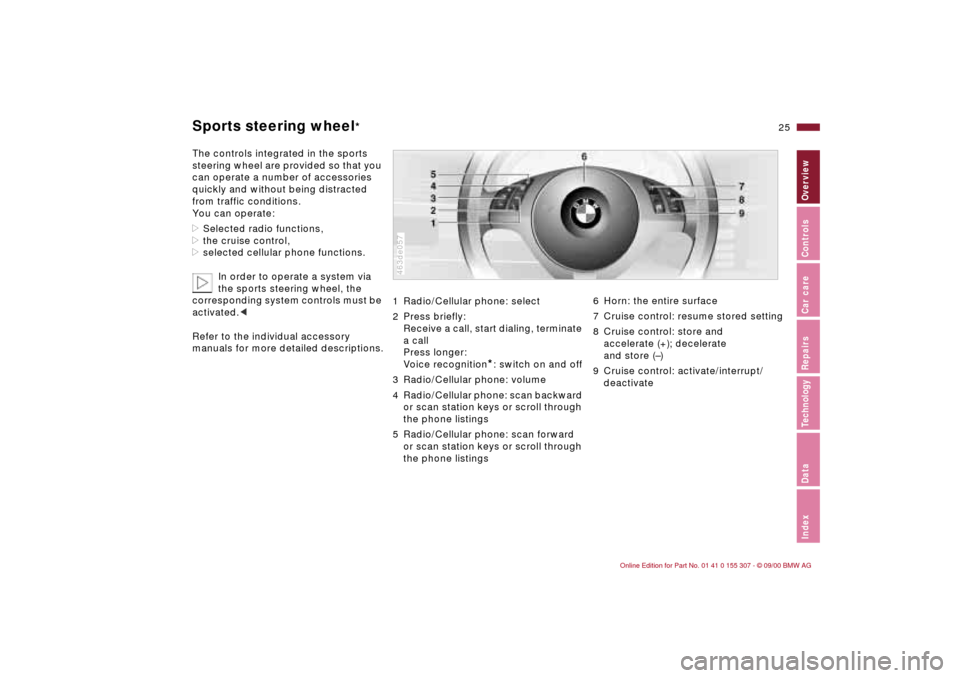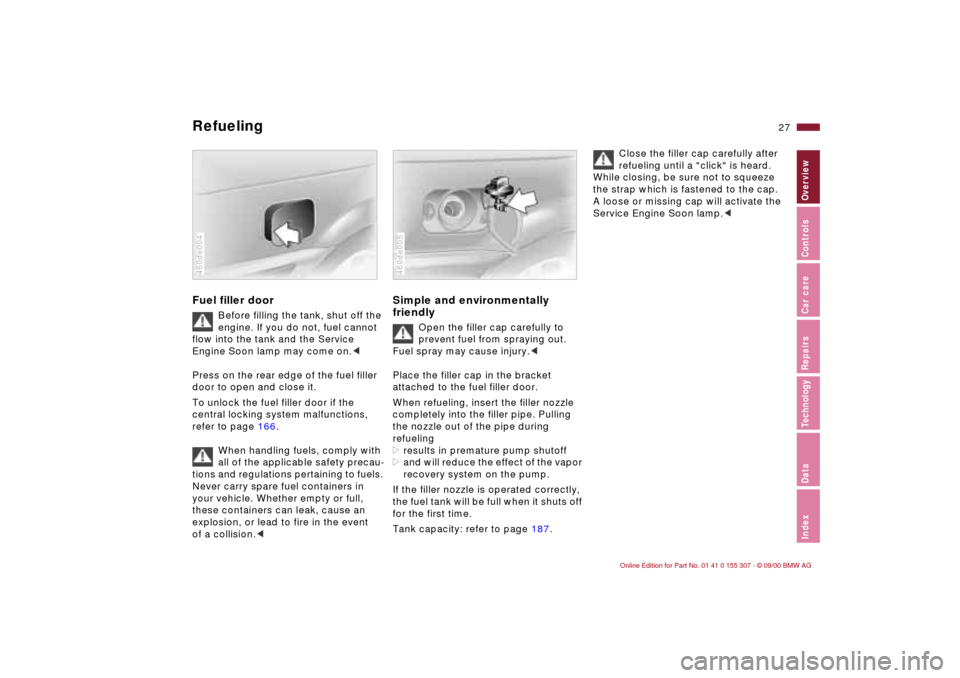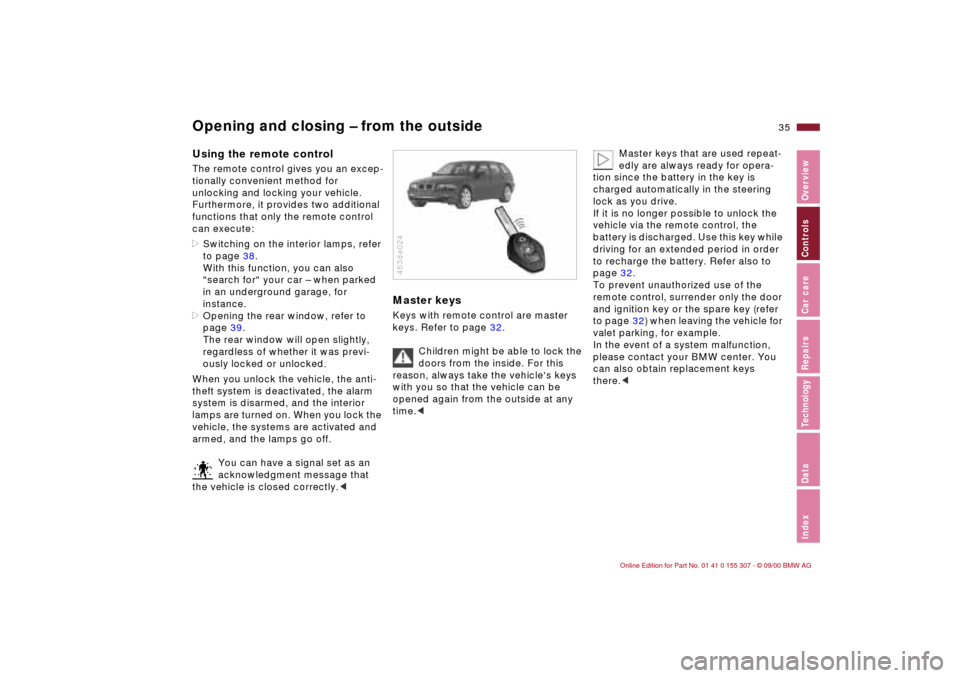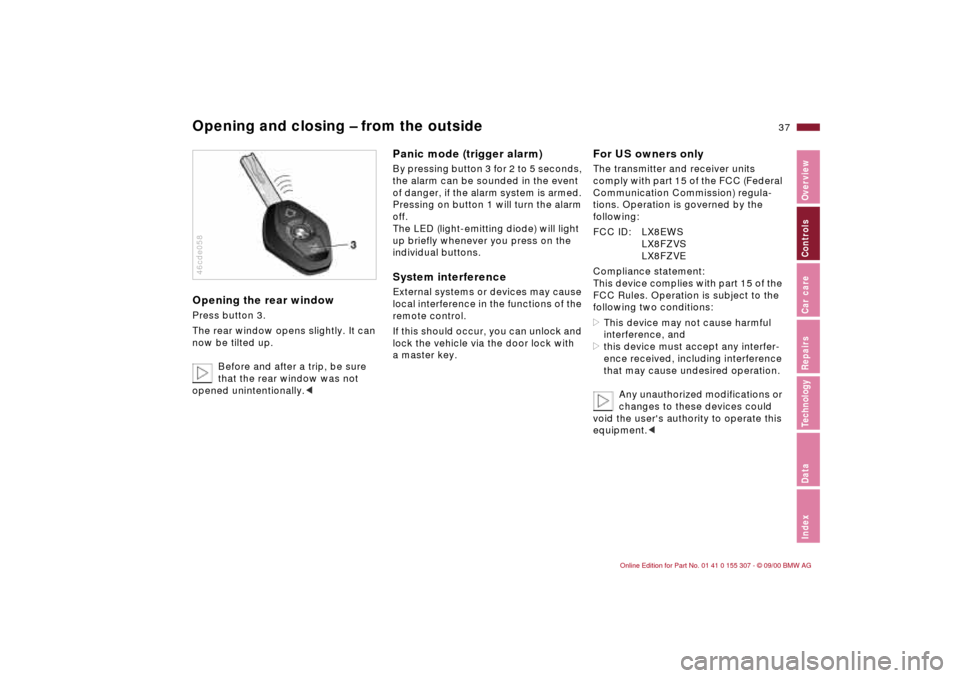2001 BMW 330i TOURING Car care
[x] Cancel search: Car carePage 23 of 203

23n
IndexDataTechnologyRepairsCar careControlsOverview
Indicator and warning lamps
Service Engine Soon l
If the indicator lamp comes on
either continuously or intermit-
tently, this indicates a fault in the emis-
sions-related electronic systems.
Although the vehicle remains opera-
tional, you should have the systems
checked by your BMW center at the
earliest possible opportunity.
For additional information, refer to
page 149.
Service Engine Soon warning
lamp for Canadian models.
Engine electronics
*
There is a fault in the engine's
electronic control system. The
electronics allow for continued driving
with reduced engine output or rpms.
Please have the system inspected by
your BMW center.
Add coolant
The coolant level is too low. Top
off the coolant at the earliest
opportunity.
For additional information, refer to
page 137.
Green: for your information
Turn signal indicator
Flashes when the turn signal is
operated. Rapid flashing indi-
cates a system malfunction.
For additional information, refer to
page 68.
Cruise control
Comes on when the cruise
control is activated. Available for
operation via the multifunction steering
wheel.
For additional information, refer to
page 71.
Fog lamps
Comes on whenever you switch
on the fog lamps.
For additional information, refer to
page 88.
Blue: for your information
High beams
Comes on when the high beams
are on or the headlamp flasher
is actuated.
For additional information, refer to
pages 68, 88.
Page 25 of 203

25n
IndexDataTechnologyRepairsCar careControlsOverview
Sports steering wheel
*
The controls integrated in the sports
steering wheel are provided so that you
can operate a number of accessories
quickly and without being distracted
from traffic conditions.
You can operate:
>Selected radio functions,
>the cruise control,
>selected cellular phone functions.
In order to operate a system via
the sports steering wheel, the
corresponding system controls must be
activated.<
Refer to the individual accessory
manuals for more detailed descriptions.
1 Radio/Cellular phone: select
2 Press briefly:
Receive a call, start dialing, terminate
a call
Press longer:
Voice recognition
*: switch on and off
3 Radio/Cellular phone: volume
4 Radio/Cellular phone: scan backward
or scan station keys or scroll through
the phone listings
5 Radio/Cellular phone: scan forward
or scan station keys or scroll through
the phone listings
463de057
6 Horn: the entire surface
7 Cruise control: resume stored setting
8 Cruise control: store and
accelerate (+); decelerate
and store (Ð)
9 Cruise control: activate/interrupt/
deactivate
Page 27 of 203

27n
IndexDataTechnologyRepairsCar careControlsOverview
Refueling Fuel filler door
Before filling the tank, shut off the
engine. If you do not, fuel cannot
flow into the tank and the Service
Engine Soon lamp may come on.<
Press on the rear edge of the fuel filler
door to open and close it.
To unlock the fuel filler door if the
central locking system malfunctions,
refer to page 166.
When handling fuels, comply with
all of the applicable safety precau-
tions and regulations pertaining to fuels.
Never carry spare fuel containers in
your vehicle. Whether empty or full,
these containers can leak, cause an
explosion, or lead to fire in the event
of a collision.<
460de004
Simple and environmentally
friendly
Open the filler cap carefully to
prevent fuel from spraying out.
Fuel spray may cause injury.<
Place the filler cap in the bracket
attached to the fuel filler door.
When refueling, insert the filler nozzle
completely into the filler pipe. Pulling
the nozzle out of the pipe during
refueling
>results in premature pump shutoff
>and will reduce the effect of the vapor
recovery system on the pump.
If the filler nozzle is operated correctly,
the fuel tank will be full when it shuts off
for the first time.
Tank capacity: refer to page 187.
460de005
Close the filler cap carefully after
refueling until a "click" is heard.
While closing, be sure not to squeeze
the strap which is fastened to the cap.
A loose or missing cap will activate the
Service Engine Soon lamp.<
Page 29 of 203

29n
IndexDataTechnologyRepairsCar careControlsOverview
BMW Tires
All pressure specifications in
the table are indicated in psi
(kilopascal) for cold tires
(cold = ambient temperature)
325
325xiAll summer tires and
the all season tire
205/55 R 16 91 H M+S32 (220) 38 (260) 38 (260) 45 (310)
All winter tires and
the all season tire
205/50 R 17 93 V M+S
35 (240) 41 (280) 41 (280) 48 (330)
Space-saver tire in the luggage
compartment61 (420)
For all season tires use the same inflation pressure as for summer tires.
For extra load tires 205/50 R 17 93 W use the same tire inflation pressure as for
winter tires.
Tire inflation pressureObserve tire approval
specificationsThe inflation pressures in the table
apply to tires made by BMW-approved
manufacturers. Your BMW center is
familiar with these pressures. Higher
pressures may be specified for tires
made by other manufacturers. You will
find a list of approved tires beginning
on page 129.
Your vehicle is equipped with tires that
meet US and European standards. We
recommend the exclusive use of
BMW-approved tires.
Page 31 of 203

Overview
Controls and features
Operation, care
and maintenance
Owner service procedures
Technical data
Index Advanced technology
31n
IndexDataTechnologyRepairsCar careControlsOverview
Driving:
Steering/Ignition lock61
Starting the engine61
Switching off the engine62
Parking brake63
Manual transmission64
Automatic transmission
with Steptronic65
Turn signal indicator/Headlamp
flasher68
Washer/Wiper system68
Rear window defroster70
Cruise control71
Everything under control:
Odometer73
Tachometer73
Energy Control73
Fuel gauge74
Coolant temperature gauge74
Service Interval Display74
Check Control75
Clock75
Computer76
Technology for safety and
driving convenience:
Park Distance Control (PDC)78
Automatic Stability Control plus
Traction (ASC+T)79
Dynamic Stability Control
(DSC)80
Tire Pressure Control (RDC)85Lamps:
Side lamps/Low beams87
Instrument lighting87
High beams/Parking lamps88
Fog lamps88
Interior lamps88
Controlling the climate
for pleasant driving:
Air conditioner90
Automatic climate control96
Seat heating100
Cabin convenience:
HiFi system101
Glove compartment101
Storage compartments102
Cellular phone103
Ashtray, front104
Cigarette lighter104
Ashtray, rear105
Power outlet105
Loading and transporting:
Ski bag106
Cargo area107
Cargo loading110
Roof-mounted luggage rack111
Page 33 of 203

33n
IndexDataTechnologyRepairsCar careControlsOverview
Electronic vehicle immobilizer The key to securityYour BMW is equipped with a passive
anti-theft system. This electronic immo-
bilization system reduces the likelihood
of your vehicle being stolen by making
it impossible to start the engine using
any keys other than the ones furnished
with the vehicle. Your BMW center can
cancel the electronic system authoriza-
tion for individual keys (in the event of
loss, for instance). A deactivated key
can no longer be used to start the
engine.46cde060
How the electronics workAt the heart of this system is an elec-
tronic chip that is integrated into the
key. The lock mechanism itself is actu-
ally a dual-function device. While the
engine is running, the circuitry in the
ignition key and the vehicle's electronic
system constantly exchange variable,
vehicle-specific signals. The system will
not release the ignition, fuel injection
and starter unless it recognizes an
"authorized" key.
Force applied to the key can
damage the integrated electronic
circuitry. A damaged key can no longer
be used to start the engine.<
Page 35 of 203

35n
IndexDataTechnologyRepairsCar careControlsOverview
Opening and closing Ð from the outside Using the remote controlThe remote control gives you an excep-
tionally convenient method for
unlocking and locking your vehicle.
Furthermore, it provides two additional
functions that only the remote control
can execute:
>Switching on the interior lamps, refer
to page 38.
With this function, you can also
"search for" your car Ð when parked
in an underground garage, for
instance.
>Opening the rear window, refer to
page 39.
The rear window will open slightly,
regardless of whether it was previ-
ously locked or unlocked.
When you unlock the vehicle, the anti-
theft system is deactivated, the alarm
system is disarmed, and the interior
lamps are turned on. When you lock the
vehicle, the systems are activated and
armed, and the lamps go off.
You can have a signal set as an
acknowledgment message that
the vehicle is closed correctly.<
Master keysKeys with remote control are master
keys. Refer to page 32.
Children might be able to lock the
doors from the inside. For this
reason, always take the vehicle's keys
with you so that the vehicle can be
opened again from the outside at any
time.<463de024
Master keys that are used repeat-
edly are always ready for opera-
tion since the battery in the key is
charged automatically in the steering
lock as you drive.
If it is no longer possible to unlock the
vehicle via the remote control, the
battery is discharged. Use this key while
driving for an extended period in order
to recharge the battery. Refer also to
page 32.
To prevent unauthorized use of the
remote control, surrender only the door
and ignition key or the spare key (refer
to page 32) when leaving the vehicle for
valet parking, for example.
In the event of a system malfunction,
please contact your BMW center. You
can also obtain replacement keys
there.<
Page 37 of 203

37n
IndexDataTechnologyRepairsCar careControlsOverview
Opening and closing Ð from the outsideOpening the rear windowPress button 3.
The rear window opens slightly. It can
now be tilted up.
Before and after a trip, be sure
that the rear window was not
opened unintentionally.<46cde058
Panic mode (trigger alarm)By pressing button 3 for 2 to 5 seconds,
the alarm can be sounded in the event
of danger, if the alarm system is armed.
Pressing on button 1 will turn the alarm
off.
The LED (light-emitting diode) will light
up briefly whenever you press on the
individual buttons.System interferenceExternal systems or devices may cause
local interference in the functions of the
remote control.
If this should occur, you can unlock and
lock the vehicle via the door lock with
a master key.
For US owners onlyThe transmitter and receiver units
comply with part 15 of the FCC (Federal
Communication Commission) regula-
tions. Operation is governed by the
following:
FCC ID: LX8EWS
LX8FZVS
LX8FZVE
Compliance statement:
This device complies with part 15 of the
FCC Rules. Operation is subject to the
following two conditions:
>This device may not cause harmful
interference, and
>this device must accept any interfer-
ence received, including interference
that may cause undesired operation.
Any unauthorized modifications or
changes to these devices could
void the user's authority to operate this
equipment.<